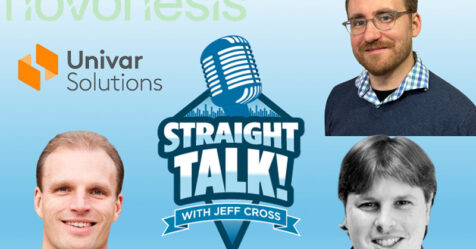Smart restroom technology is no longer the future—it is the here and now—so accepting its role in day-to-day life is not optional. For facility managers, particularly those who do not consider themselves tech-savvy, this reality can be intimidating.
Fortunately, a good technology partner will work with facility managers and do most of the heavy lifting needed for implementing smart technology. The partner will install and deploy the systems, and then properly train facility managers and custodial teams on using the system and leveraging the data. The partner will also provide ongoing support to help facility managers meet the organization’s goals related to cost, waste reduction, hygiene, and productivity.
Despite the assistance from a technology partner, facility managers must still be knowledgeable about the design, installation, and deployment of smart restroom solutions to ensure a successful implementation. The following five tips can help them set their facility up for success.
1–Understand the basics
In the simplest terms, smart restroom technology connects sensors inside restroom fixtures to an app on a phone, tablet, or computer using the Internet of Things (IoT). The sensors collect data in real time and send it, via wireless technology, to an app where facility managers, building services contractors (BSCs), and custodians can see it, analyze it, and act on it.
Connected restroom fixtures can include soap, paper towel, and toilet tissue dispensers; faucets and flush valves; occupancy monitors; and more. The data collected reveals how frequently patrons use the restroom, how much product they use, and how much product is available. The data can also indicate water flow and consumption
rates, the most and least frequently used stalls, and dispenser battery life. The insights gleaned from the data allow for informed cleaning and maintenance decision-making, as well as improved custodian workflows.
In essence, smart restroom technology gives those responsible for restroom maintenance eyes on what requires attention and when, so they only need to enter the restroom when necessary. This type of traffic-based preventive maintenance frees staff to perform additional and potentially higher-value cleaning and maintenance tasks. It positively impacts productivity, sustainability, safety, tenant satisfaction, and return on investment.
2–Don’t skimp on research
When it comes to pursuing a smart facility, there is no such thing as too much knowledge. The Internet provides access to resources that can help educate facility managers on the mechanisms, benefits, and implementation of smart restroom technology. The internet also puts the names of potential technology partners at facility managers’ fingertips. When relying on the internet, managers should look for technology providers whose solutions have been recognized with industry awards and who have experience in their category.
Beyond the internet, facility managers can network with their industry peers for first-hand accounts about implementing smart restroom solutions. Their peers may disclose what they wished they had known going into the process, as well as the barriers they encountered, and rate the helpfulness of their technology partner. Knowing what their peers experienced and with whom can be a valuable source of information for facility managers considering a migration to smart restrooms.
Industry associations can be another valuable source of information, as they have a primary goal of helping their members achieve business success. Through trade shows, webinars, and other engagement opportunities, these
associations can guide facility managers on their smart technology journey.
3–Secure your organization’s support
Facility managers bear much of the responsibility for recognizing the benefits of smart restroom technology and then leveraging that technology to achieve those benefits. To do so, they need to first identify their organization’s pain points and then determine the impact smart restroom technology can have on these problems. Typical pain points include companywide cost-cutting measures, poor productivity among the cleaning staff, or frequent restroom complaints from tenants. Facility priorities often focus on meeting sustainability goals, achieving higher tenant satisfaction ratings, or demonstrating a commitment to hygiene. Clarity in these areas will not only assist facility managers with the technology design and installation process, it will also help them sell the idea of investing in smart technology to company leadership.
Imagine going through the time, effort, and resources to deploy a smart restroom solution only to discover that your organization’s leadership, information technology (IT), and human resources teams do not support the project or are uncooperative because they were not involved from the outset. Their support and hands-on
involvement are vital to the success of the project, from the planning stage through the final setup.
Installation timing is another key factor in ensuring the successful deployment of a smart restroom solution. Infrastructure upgrades are disruptive to building occupants as they could encounter a temporary lack of internet access, closed restrooms, or technicians in their workspace. To limit these disruptions, facility managers can collaborate with staff in human resources and other key departments to determine the best implementation timing possible. They should consider production windows, vacation schedules, off-seasons, or already-planned renovations when choosing a time to install restroom technology. While there might not be a perfect time to proceed with installation, there is likely a better time.
4–Familiarize yourself with the installation lingo
While facility managers can place much of the implementation process in the hands of technology and building engineering managers, they are the ones who need to ensure the technology delivers on its promises. Therefore,
they will benefit from understanding some of the implementation and deployment language.
For example, the network infrastructure includes the hardware, software, services, and other components that allow connected devices to communicate with each other. Routers, LAN cards, and cables are examples of hardware. Operating systems and firewalls are examples of software. Wireless protocols, IP addressing, and cloud connectivity services are examples of services. Familiarity with these terms will empower facility managers to engage in more meaningful conversations with their technology partner and internal stakeholder. It will also allow them to participate proactively in the discovery and mapping processes to identify network access points and confirm restroom locations.
5–Remain committed to the technology
After facility managers purchase a piece of equipment and leave it in the hands of capable cleaning staff, they probably dismiss that equipment from their mind. However, smart restroom solutions, unlike other types of equipment, require a facility manager’s ongoing attention to review and analyze its data then create appropriate action plans.
These tasks will take less time as facility managers become more comfortable with the equipment, but managers will need to remain involved to get the most out of the technology. This includes building a positive, ongoing
relationship with the technology partner to revise metrics, give context to the data, troubleshoot, and expand coverage areas.
A continual journey
The facility maintenance industry is still in the beginning stages of adopting smart solutions to help optimize building operations, but there is no turning back. The flood gates have opened with the introduction of smart HVAC systems, lighting, security systems, restrooms, and more. Committing to the journey is the only way facility managers can survive and thrive.



